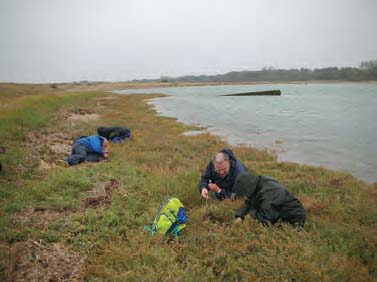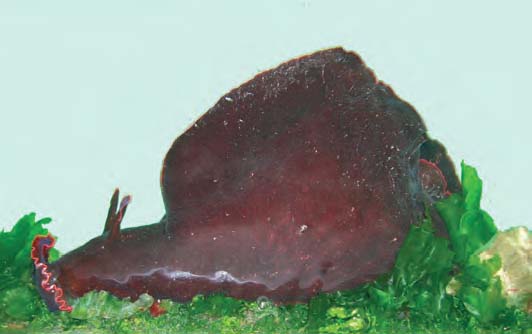Issue
17
Page
30
|
Data policy for records
In my report for 2006 I outlined the Society’s decision to make all validated records for marine molluscs freely available and I would like to remind members that a copy of the Policy on release of data is provided in the Members’ Guide. Those people who have submitted records to the Society Recorders and for whom we have contact details should have received a letter from the President requesting that they give their permission for release of data (for all molluscan records not just marine). Other contributors remain to be tracked down. Whilst there has been a very positive response in terms of replies and willingness to release records (we have only received one outright refusal) we are still waiting for replies from others. This means that a majority of records on the marine database are now freely available under the Society’s policy, but a tranche of records are tagged against downloading for NBN purposes and are thus effectively frozen, until letters of permission from the respective contributors are received by the President on behalf of the Society. I would like to remind members too that should they have concerns over certain records or aspects of data release, they are at liberty to make separate data release agreements with the Society.
Noteworthy records
I am grateful to Paul Brazier of CCW for drawing my attention to the occurrence of Petricola pholadiformis living in Holocene clays in the Dee estuary North Wales (Sea Area 24 Liverpool Bay). It lives with Barnea candida, which it superficially resembles, although Petricola is a venerid not a pholad. In the Netherlands and Belgium it has been observed that Petricola has a tendency to replace the piddock Barnea candida. Petricola is a species native to the USA and must have been introduced, unintentionally, no later than 1890, when it was found in the River Crouch, Essex with the American oyster Crassostrea virginica. In Britain it is mainly distributed along south and east coasts of England from Dorset round to the Humber and this new record represents a disjunct occurrence of the species in North Wales. The record is interesting because it overturns an entry in the MMNWE. There Dennis Seaward deleted a previous record for S24 made by the late Nora McMillan. Possibly it was considered suspect, presumably on the basis of its disjunct occurrence. Paul’s find confirms that the species is indeed living in that Sea Area.
Atrina fragilis: This species has featured regularly in recent annual reports. In April, three individuals were found in the Salcombe and Kingsbridge estuary in Devon. This followed a sighting of a single individual the month before. Whilst one might lament the paucity of individuals being reported, it is gratifying to know that the species has a sufficiently high profile that people are reporting occasional specimens. There are now reports for 18 individuals of the species and these are monitored. Larger fanshell beds are known to occur in Cornish and Scillonian waters but are highly vulnerable to trawl fishing.
Caecum armoricum: At the beginning of the year Caecum armoricum de Folin, 1869 was known to be living only in the Fleet, Dorset, having been discovered there by Dennis Seaward (Marine Recorder at that time) in 1986. He found up to 100 living specimens and many shells in pebble samples from sites on the landward side of the Chesil Bank where springs emanate from the shingle and drain into the Fleet. Now, some 20 years later two further sites for C. armoricum have come to light. In July Celia Pain carried out survey work with Kent Wildlife Trust at saline lagoons on Lydd Ranges (Army Training Estate). She sieved mud and pebbles from the bottom of a lagoon at the site. At home she found live Caecum which appeared to be C. armoricum. These were confirmed by Dennis Seaward. In October at Pagham Harbour, Steve Wilkinson found the species living in a similar habitat (Figure 1) and closely associated with Truncatella subcylindrica, which also occurs in the Fleet. A more detailed account of these finds will appear in Journal of Conchology.
Aplysia species: Marine workers are familiar enough with the common aplysiid of our shores, Aplysia punctata. It can be found amongst weeds in very shallow water and in rock pools. Records for the other two Aplysia species known from northeast Atlantic waters have always been scarce. Until last year there were only three authenticated records for A. fasciata (Figure 2) from British shores and a number of misidentifications. Between the end of August and December 2007 16 separate sightings were reported, all from southwest England, Scilly or the Channel Islands and collated by Douglas Herdson at the Plymouth Marine Aquarium. Thompson (1976. Biology of Opisthobranch Molluscs Volume I.) has described the species as rare on our shores although it is locally common on the Atlantic coast of France and in the Mediterranean Sea and West Africa. A species, then, that would appear to be migrating northwards. The other hitherto rare visitor to our shores is Aplysia depilans. The species has a broad, dark red/brown foot unlike Aplysia punctata, which has a narrow foot which is yellowish white. It is also distinguished from A. punctata in that the parapodia are fused posteriorly. Richard Lord has photographed a fine specimen on Jersey (Figure 3), the only previous record for the species from the Channel Islands being in 1949. I am grateful to Richard Lord and Andrew Syvret (both of Jersey) for allowing me to include their photos of the 2 species.
Further to the finding of Assiminea grayana at Haverthwaite in Cumbria reported last year, Simon Taylor has found another site, this time at Bolton-le-Sands at the top of Morecambe Bay (Mollusc World 14 July 2007). His find was serendipitous in that he observed snails he believed to be hydrobiids crawling over a Thornback Ray egg-case and only later identified them correctly.
Julia Nunn continues to report new and updated (post 1990) live records from Irish Sea Areas: (see below)
It is timely to remind members that the marine recording scheme covers the continental coast of Europe. Not many records are forthcoming although the advent of electronic databases and moves towards data exchange agreements could reverse that trend. From the other side of the English Channel there are 2 new records. Leptochiton scabridus is the smallest chiton species in northeast Atlantic waters and can be found at ELW and sublittorally attached to stones or pebbles which are often embedded in sand to a depth of 10-20 cm. A single specimen was taken from a small semi-embedded cobble on the muddy sandy shore at St Vaast La Hougue on the east Cotentin peninsula in Normandy during survey work at the Equinox tides in March 2007 by Celia Pain. This is the first record for the species from SA54, Seine. On the same trip a single live specimen of Cerithiopsis pulchella was taken from weedwashings at Portbail on the west Cotentin, SA17F, Bay of St Malo. These are both new Sea Area records.
I am pleased to see new names amongst those submitting records, notably Richard Lord who has been a regular contributor of observations, accompanied by excellent photographs of the molluscs he finds on Jersey, all this made so easy via the Internet. (His website www.sealordphotography.net is worth a visit.) This has greatly improved the process of identification and confirmation of specimens, especially species which are too delicate or large to pass through the post in good condition. In addition to those mentioned above I also thank Tom Clifton, John Llewellyn Jones, Julia Nunn, Celia Pain, Shelagh Smith, Mike Weideli and Steve Wilkinson all of whom are supporting marine recording in the Society in various ways. All the records mentioned in this report are new information to the Society’s Marine Census.
|
 Figure 1: Upper shoreline at Church Norton, Pagham just before high tide. Searching is taking place amongst the shingle beneath the plants of Halimione portulacoides and Suaeda spp. photo Jan Light.
 Figure 2: Aplysia fasciata photographed in a tank by Andrew Syvret. A distinguishing feature of the animal is the red colouration on the edge of the parapodial and frontal lobes.
 Figure 3: Aplysia depilans photographed by Richard Lord from a tide pool in Belle Greve Bay, Guernsey. The animal, described as larger than a fist and resembling the holdfast of a furbelows (the kelp, Saccorhiza polyschides), was attached to the underside of a boulder. Image ©RLLord, Sealordphotography.
|
